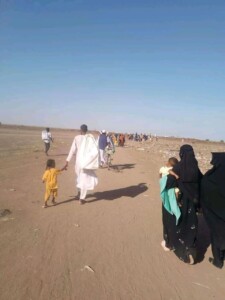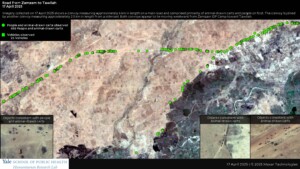Floods: Dire suffering in Darfur camps and across Sudan
Around 226,200 people have been affected as torrential rains and flash floods continue to wreak havoc across Sudan. The Coordination of the Darfur Camps for Displaced People and Refugees report dire humanitarian conditions due to ongoing heavy rains during the month of August.
 Flood devastation in Sudan (Social media)
Flood devastation in Sudan (Social media)
Around 226,200 people have been affected as torrential rains and flash floods continue to wreak havoc across Sudan. The Coordination of the Darfur Camps for Displaced People and Refugees report dire humanitarian conditions due to ongoing heavy rains during the month of August.
In a statement yesterday, the Darfur Camp Coordination said that heavy rainfall last week caused the death of three children, and the complete collapse of more than 200 homes in Kalma camp near Nyala, capital of South Darfur, forcing the displaced to seek refuge in schools and mosques.
Many children are suffering from poor health as well. The number of children suffering from malnutrition increased to 5,250, the child feeding centres in the camp reported. With about 300,000 residents, Kalma camp is one of the largest in Darfur.
The spokesperson for the Camp Coordination, Adam Rujal, appealed to humanitarian organisations and charities to provide the affected displaced in the camps in Darfur, especially the Kalma, Kass, and Zamzam camps, with food, medicine, and non-food items such as tarpaulins and others.
OCHA: Flood havoc across Sudan
In its latest update issued on Sunday, the UN Office for the Coordination of Humanitarian Affairs (OCHA) reports that to date, according to the Sudan government’s Humanitarian Aid Commission (HAC), humanitarian organisations on the ground, and local authorities, an estimated 226,200 people have been affected as torrential rains and flash floods continue to wreak havoc across Sudan.
According to the report, The rains and floods destroyed at least 13,200 houses and damaged another 34,200 in 15 states. The government authorities reported that 89 people died and more than 30 people were injured since the beginning of the rainy season.
The most affected states are Gedaref (45,270 people) Central Darfur (39,448), South Darfur (30,677), White Nile (26,592), Kassala (25,890), River Nile (15,722) and West Darfur (15,504). Nine other states have also been affected to varying degrees: West Kordofan (5,855), South Kordofan (5,765), North Kordofan (4,410), East Darfur (3,650), Sennar (3,164), El Gezira (2,250), Khartoum (1,296), and North Darfur (686).
The floods have reportedly affected at least 500 health facilities, 1,000 water sources and over 2,500 latrines have been damaged or destroyed. People have lost over 740 head of livestock and over 12,000 feddans (over 5,000 hectares) of agricultural land were affected by floods, which will contribute to already worrying levels of food insecurity.
In 2022, more than 460,000 people could be affected by the floods, according to the 2022 Sudan Emergency Response Plan (ERP). In 2021, about 314,500 people were affected across Sudan, while between 2017 and 2021 on average 388,600 people were affected annually.
According to the IGAD Climate Prediction and Applications Centre (ICPAC) forecast for 23-30 August, heavy rainfall (above 200 mm) is expected to hit a few locations in southern Sudan. Moderate rainfall (50-200 mm) is expected over southern to central Sudan, and light rainfall (less than 50 mm) is expected in central to northern Sudan.
The water levels along the Nile and Atbara rivers are increasing, with the peak of the rainy season approaching. On 27 August, the water levels at Khartoum and Atbara (some 300 km northeast of Khartoum) water stations were recorded at 16.75 metres and 15.88 metres respectively, both exceeding flooding risk levels. In Ed Dein station, 554 km south-east of Khartoum, the water level was recorded at 12.17 metres, which is above the critical level, but below the flooding risk level of 12.30 metres. In Shandi (northern Sudan), the water level is 17.20 metres, which is above the critical level of 17.10 metres, but below the flooding risk level of 17.60 metres.
The rainy season in Sudan usually starts in June and lasts up to September, with the peak of rains and flooding observed between August and September. For more information on floods and updated figures of people affected and areas, as well as rainfall forecast and water levels at water stations on the Nile River please see the OCHA 2022 Floods Dashboard.











 and then
and then